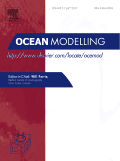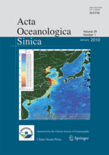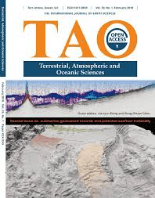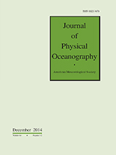
OCEAN MODELLING
Scope & Guideline
Charting New Territories in Marine Modeling.
Introduction
Aims and Scopes
- Numerical Ocean Modelling:
The core focus of the journal is on the development and application of numerical models to simulate oceanic processes. This includes the modeling of ocean currents, waves, tides, and interactions with the atmosphere. - Biogeochemical Processes:
Research on the interplay between physical ocean dynamics and biogeochemical cycles is a significant aspect. This includes studies on nutrient cycling, carbon fluxes, and the impacts of ocean chemistry on marine ecosystems. - Climate Change Impacts:
The journal frequently publishes studies examining the effects of climate change on ocean systems, including sea level rise, ocean warming, and changes in ocean circulation patterns. - Data Assimilation Techniques:
A strong emphasis is placed on data assimilation methods that integrate observational data into ocean models to improve predictive capabilities and model validation. - Machine Learning Applications:
Emerging methodologies involving machine learning and artificial intelligence are increasingly featured, showcasing their application in enhancing model accuracy and forecasting capabilities. - Coastal and Estuarine Dynamics:
Research focusing on coastal and estuarine environments, including storm surge modeling, sediment transport, and coastal ecosystem interactions, is prominently represented. - Interdisciplinary Approaches:
The journal encourages interdisciplinary research that combines oceanography with atmospheric sciences, hydrology, and environmental science to address complex oceanic challenges.
Trending and Emerging
- Advanced Machine Learning Techniques:
The use of machine learning and artificial intelligence in ocean modeling is rapidly increasing. This includes applications for predicting ocean dynamics, optimizing model parameters, and assimilating observational data. - Multi-Scale Modeling Approaches:
There is a trend towards multi-scale modeling, which integrates various spatial and temporal scales to provide a more comprehensive understanding of ocean dynamics and their interactions with climate systems. - Impact of Marine Heatwaves:
Research focusing on marine heatwaves and their ecological and biogeochemical impacts is gaining prominence, reflecting the growing concern over climate change effects on marine environments. - Coupled Ocean-Atmosphere Models:
Studies integrating ocean and atmosphere modeling are on the rise, emphasizing the importance of understanding coupled systems in predicting weather patterns and climate variability. - Coastal Resilience and Adaptation Strategies:
Increasingly, papers are addressing coastal resilience and adaptation strategies in response to climate change, highlighting the need for sustainable management of coastal resources. - Ocean Data Assimilation Innovations:
Innovations in data assimilation techniques are trending, with a focus on improving model accuracy and predictive capabilities through the integration of diverse data sources, including satellite observations.
Declining or Waning
- Traditional Hydrostatic Models:
There appears to be a decline in the publication of studies solely relying on traditional hydrostatic models, as newer, more sophisticated modeling techniques that capture non-hydrostatic effects gain traction. - Basic Wave Theory Applications:
Research focused on basic wave theory without integration into more complex models or real-world applications is less frequently represented, indicating a shift towards more applied and interdisciplinary studies. - Static Parameterizations:
Static parameterization methods in ocean models are being phased out in favor of dynamic and adaptive approaches that better account for variability in ocean conditions. - Standalone Empirical Models:
There is a noticeable reduction in standalone empirical models that do not incorporate physical principles or data assimilation, as the community increasingly values integrated and data-driven approaches.
Similar Journals

Ocean Systems Engineering-An International Journal
Bridging Disciplines: Engineering Solutions for Ocean ChallengesOcean Systems Engineering - An International Journal, published by TECHNO-PRESS, is a pivotal platform for the dissemination of cutting-edge research in the fields of Automotive Engineering, Mechanical Engineering, Ocean Engineering, and Water Science and Technology. With its ISSN 2093-6702 and E-ISSN 2093-677X, the journal serves as a key resource for scholars and practitioners alike, offering insights into innovative solutions and advancements within these disciplines. Operating under a Q3 ranking in several categories including Automotive and Ocean Engineering, the journal showcases research that significantly contributes to both theoretical and practical aspects of engineering and environmental science. Although it does not currently offer an open-access model, the journal maintains an active presence in the academic community, supported by a dedicated readership keen on exploring the latest developments from 2017 to 2024. Situated in South Korea, it is uniquely positioned to bridge international research efforts and enhance collaborative studies aimed at addressing critical ocean-related challenges.

Ocean and Coastal Research
Advancing marine science for a sustainable future.Ocean and Coastal Research, published by the Institute Oceanográfico of the University of São Paulo, is an essential academic journal dedicated to advancing the fields of Aquatic Science, Oceanography, and Water Science and Technology. Established in 2020, the journal has quickly become a noteworthy platform contributing to the understanding and sustainable management of marine and coastal ecosystems, with an open access model that promotes the dissemination of critical research findings. Although currently categorized in the fourth quartile across its respective fields in 2023, the journal serves as an emerging repository of valuable insights for researchers, professionals, and students alike, aiming to make impactful discoveries that address contemporary challenges in ocean conservation and resource management. The journal's editorial team is committed to fostering interdisciplinary collaboration and upholding rigorous peer-review standards, thereby ensuring high-quality contributions that reflect the dynamic nature of marine science. With an E-ISSN of 2675-2824, all access to published articles is freely available, supporting global research efforts addressing crucial environmental issues.

ACTA OCEANOLOGICA SINICA
Navigating the Frontiers of Ocean ResearchACTA OCEANOLOGICA SINICA, published by SPRINGER, stands as a significant voice in the fields of Aquatic Science and Oceanography, contributing vital research and insights since its inception in 1985. With an ISSN of 0253-505X and an E-ISSN of 1869-1099, this journal maintains a strong international focus, delivering high-quality peer-reviewed articles that address pressing marine and freshwater environmental issues. Although it operates under a subscription model, its Q3 ranking in both Aquatic Science and Oceanography demonstrates its solid standing within Scopus, placing it in the 48th and 44th percentiles respectively. The journal aims to foster knowledge exchange and collaboration among researchers, professionals, and students by providing a platform for innovative studies and comprehensive reviews. With a dedicated editorial board and a commitment to advancing scientific understanding, ACTA OCEANOLOGICA SINICA serves as an essential resource for anyone engaged in the study of oceanographic phenomena and aquatic ecosystems.

TERRESTRIAL ATMOSPHERIC AND OCEANIC SCIENCES
Advancing Knowledge in Atmospheric and Oceanic RealmsTERRESTRIAL ATMOSPHERIC AND OCEANIC SCIENCES, published by SpringerNature, is a distinguished peer-reviewed journal that has been an essential platform for innovative research in the fields of atmospheric science, oceanography, and Earth and planetary sciences since its inception. With an Open Access policy established in 1990, the journal ensures wide dissemination of knowledge, allowing researchers, professionals, and students to access cutting-edge findings without restrictions. Based in Switzerland and featuring a comprehensive coverage from 1996 to 2024, the journal currently holds a Q3 ranking across various categories, indicating its growing significance in the scientific community. Although it is positioned within the 39th percentile in Earth and Planetary Sciences, its commitment to fostering high-quality research makes it a valuable resource for advancing understanding of terrestrial environments and their interconnections. Researchers seeking a platform for their work in atmospheric and oceanic sciences will find TERRESTRIAL ATMOSPHERIC AND OCEANIC SCIENCES to be an ideal venue for sharing their insights with a global audience.

JOURNAL OF PHYSICAL OCEANOGRAPHY
Illuminating Climate-Ocean InteractionsJOURNAL OF PHYSICAL OCEANOGRAPHY, published by the American Meteorological Society, stands at the forefront of the oceanographic research domain, with a distinguished history dating back to 1969. As a crucial resource for researchers, professionals, and students, this journal focuses on the physical aspects of our oceans, facilitating the dissemination of innovative studies that enhance our understanding of ocean dynamics, climate interactions, and marine ecosystems. With an impressive impact factor and a Q1 ranking in Oceanography, it ranks 30th out of 145 journals in the Earth and Planetary Sciences category (Scopus), placing it in the 79th percentile of its field. Its commitment to high-quality, peer-reviewed content ensures that the latest advances in oceanographic science are accessible to a global audience. Although the journal does not currently offer open access options, it remains a vital platform for cutting-edge research that shapes the future of oceanographic science and its applications.

Journal of Ocean University of China
Fostering Collaboration in Oceanic ExplorationThe Journal of Ocean University of China, ISSN 1672-5182, is a premier academic journal dedicated to advancing the fields of Ocean Engineering and Oceanography. Published by the esteemed Ocean University of China, the journal serves as a vital platform for researchers, professionals, and students to disseminate groundbreaking findings and foster collaboration in marine science and engineering. With a commitment to quality, the journal currently holds a Q3 ranking in both Ocean Engineering and Oceanography as of 2023, indicating its significant contributions within the scientific community. The journal's scope encompasses a wide range of topics including marine technology, ecological studies, and coastal management, all aimed at enhancing the understanding and utilization of oceanic resources. Although currently not Open Access, it continues to attract submissions from renowned scholars, ensuring a diverse and innovative range of research. By providing access to cutting-edge research and practical insights, the Journal of Ocean University of China plays a critical role in shaping the future of ocean sciences and engineering.

IZVESTIYA ATMOSPHERIC AND OCEANIC PHYSICS
Innovating research for a sustainable environmental future.Izvestiya Atmospheric and Oceanic Physics is a distinguished journal dedicated to advancing the fields of atmospheric science and oceanography, published by MAIK Nauka/Interperiodica/Springer. With a rich publication history spanning from 1972 to the present, this journal serves as a vital platform for both theoretical and experimental studies that enhance our understanding of complex atmospheric and oceanic systems. Despite its current categorization in the Q4 quartile according to the 2023 rankings, the journal continues to provide crucial insights, as evidenced by its established ranks in Scopus—placing it in the 15th and 26th percentiles of its respective categories. Researchers, professionals, and students alike are encouraged to contribute to and engage with the latest findings published in this journal, fostering a collaborative spirit within the scientific community dedicated to tackling pressing environmental challenges.

JOURNAL OF OCEANOGRAPHY
Bridging Academia and the Ocean's MysteriesJOURNAL OF OCEANOGRAPHY, published by Springer, stands as a leading academic journal in the field, with an impressive Q1 ranking in Oceanography for 2023. Since its inception in 1992, this journal has dedicated itself to the dissemination of high-quality research that spans a diverse array of topics within oceanography and earth sciences. With an ISSN of 0916-8370 and an E-ISSN of 1573-868X, it plays a crucial role in bridging the gap between academia and practical marine applications. The journal is indexed in Scopus, ranking #57 out of 145 in its category, reflecting its rigorous academic standards and the impact of its published works, reaching a notable ile in the 61st percentile. Located in Japan, the JOURNAL OF OCEANOGRAPHY provides a vital platform for sharing significant research findings that contribute to our understanding of marine environments, aiming to foster interdisciplinary collaboration among researchers, professionals, and students dedicated to marine science.

Ocean Science Journal
Exploring the Depths of Ocean KnowledgeOcean Science Journal, published by the Korea Institute of Ocean Science and Technology (KIOST), is a pivotal resource for scholars and practitioners in the field of oceanography. With the ISSN 1738-5261 and E-ISSN 2005-7172, this journal presents cutting-edge research from 2006 to 2024, bridging fundamental and applied ocean sciences. Based in South Korea, with its headquarters located in Busan, the journal has achieved a commendable Scopus rank of #72 out of 145 in the domain of Earth and Planetary Sciences, placing it in the 50th percentile among peer publications. Classified in the Q3 category of the 2023 Oceanography rankings, Ocean Science Journal offers a platform for innovative studies that advance understanding of marine environments and promote sustainable ocean practices. While it does not operate under an open access model, readers and contributors can expect high-quality, peer-reviewed material that addresses pressing oceanic challenges and developments. This journal serves as an essential tool for researchers, professionals, and students committed to fostering marine science and ocean technology.

JOURNAL OF WATERWAY PORT COASTAL AND OCEAN ENGINEERING
Advancing Knowledge in Waterway and Coastal SystemsThe JOURNAL OF WATERWAY PORT COASTAL AND OCEAN ENGINEERING, published by the ASCE - American Society of Civil Engineers, is a premier scholarly journal devoted to the interdisciplinary fields of waterway, port, coastal, and ocean engineering. Since its inception in 1982, the journal has provided a crucial platform for researchers, professionals, and students to share innovative findings and advancements related to the engineering and management of aquatic environments. With an impressive Q2 ranking in multiple categories, including Civil and Structural Engineering, Ocean Engineering, and Water Science and Technology, the journal is recognized for its significant contributions to the field. It seeks to publish high-quality research that addresses both theoretical and practical challenges while promoting sustainable practices in marine and coastal systems. Holding a prominent Scopus rank and providing access to a global readership, the journal stands as an invaluable resource for those dedicated to advancing the science and engineering of water environments.